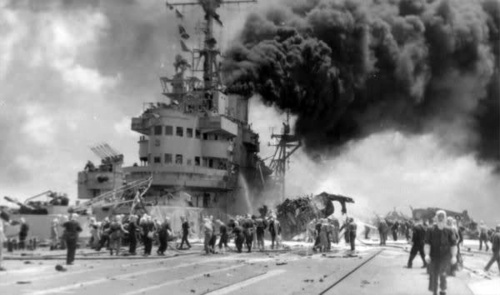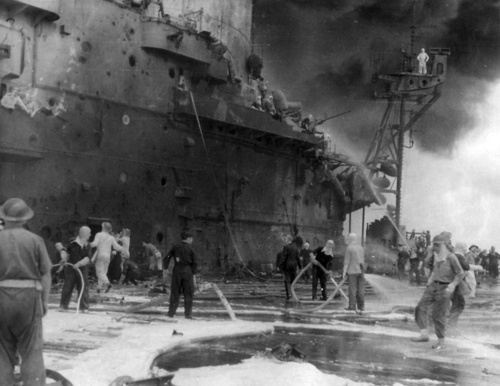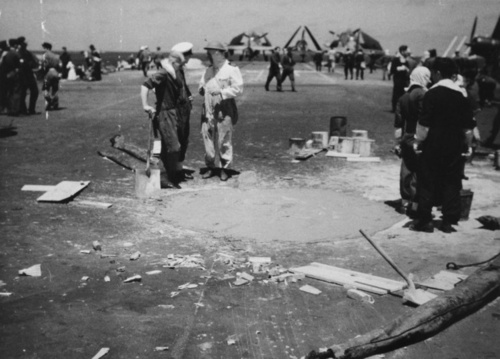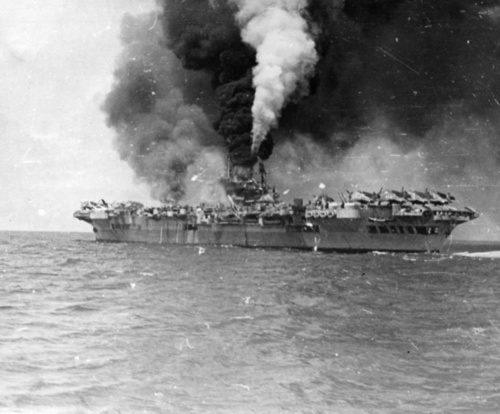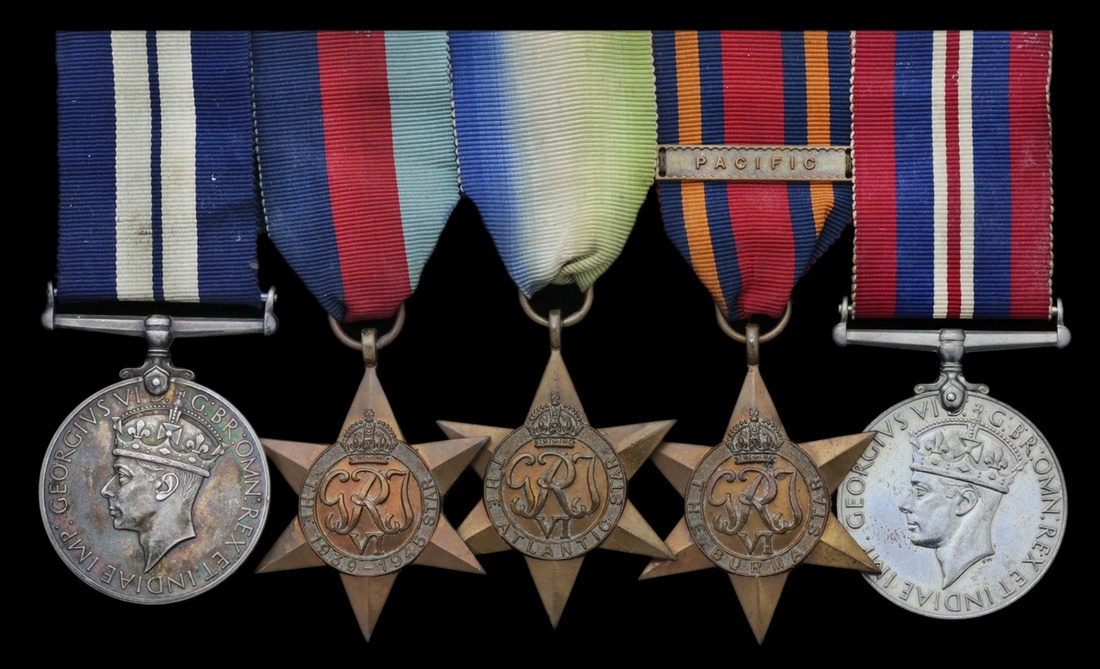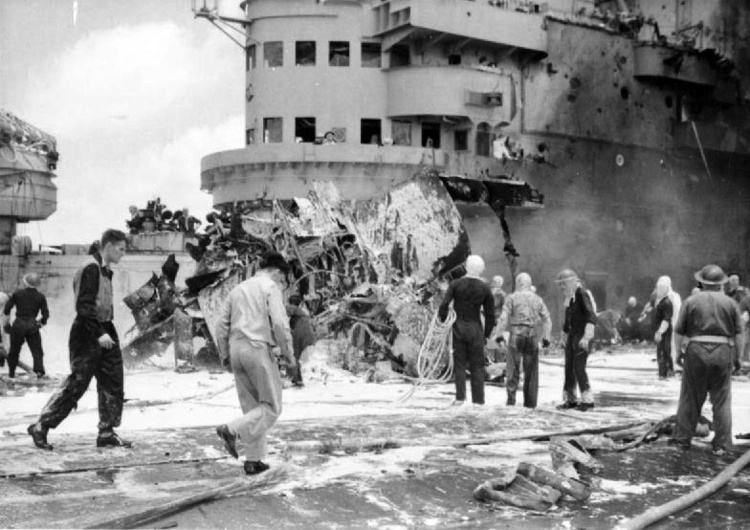Auction: 22002 - Orders, Decorations and Medals
Lot: 194
(x) 'When the next alarm-to-arms sounded I went up to my guns to find them deserted; no target officer and no crews. A nasty suspicion that they had become casualties was confirmed by one of the nearby pom-pom crew who said that the target officer was dead and that all the seamen were wounded.
When one considers the appearance of the deck immediately after the incident our casualties seemed comparatively light. Two offices and six men were killed and six officers and forty-one men wounded.
One Avenger – its pilot and the petty officer directing it – died of their wounds later – blew up with the Kamikaze and seven other aircraft on deck were completely burnt out. Other aircraft on deck were damaged. All the small tractors were destroyed and aircraft thereafter had to be moved by man – and jeep-power.
The fact that the Japanese pilot coldly decided his aim was not good enough and went round again points to a high standard of training among suicide pilots. This fellow dealt with himself very thoroughly too, for he scattered his pieces all over the place. The wrist-watch found far away on one of his hands had stopped and the gunnery officer was at one stage seen poking pieces of him off the funnel with a long stick.'
A survivor of the Kamikaze attack of 4 May 1945 in A FORMIDABLE COMMISSION refers
An outstanding immediate D.S.M. group of five awarded to Able Seaman R. H. J. Bird, Royal Navy, who was decorated for gallantly remaining on his gun - in spite of being burned - during the fateful Kamikaze attack on Formidable in May 1945
Distinguished Service Medal, G.V.R. (A.B. R. H. J. Bird. P/JX 234934), officially engraved naming; 1939-45 Star; Atlantic Star; Burma Star, clasp, Pacific, War Medal 1939-45, good very fine (5)
D.S.M. London Gazette 23 October 1945:
'For gallantry, skill and great devotion to duty whilst serving in H.M.S. Formidable…during operations performed in collaboration with the United States Navy Pacific Fleet in the capture of Okinawa and the Nansei Shoto area over a period from 26 March to 20 April 1945.'
The original recommendation states:
'For fortitude and devotion to duty in continuing to man his gun despite bad burns until all fear of further kamikaze attacks had disappeared.'
Richard Herbert James Bird was born at Stevenage, Hertfordshire on 22 March 1918 and was a compositor by trade. On 18 November 1940 he enlisted in the Royal Navy as a Hostilities Only rating. Completing training at Collingwood and Victory on 12 February 1941, he was duly drafted to Revenge.
When Bird joined the Revenge, she was based at Halifax, Canada, for convoy defence duties. She returned to the United Kingdom in March for refit on the Clyde; on her return passage to Halifax, she carried General Sikorski of the Free Polish Government, who went to Washington for a conference with Roosevelt.
In August 1941 the Admiralty considered what response it should make to threatening Japanese actions in the Far East, in particular the occupation of French Indo-China, and consideration was given to sending the four Revenge class battleships to Singapore. Churchill vetoed this plan, describing them as "coffin ships," but the Revenge and Royal Sovereign were sent to the Indian Ocean for convoy escort duties. Revenge arrived at Freetown on 31 August and at Cape Town on 11 September. During the voyage she was rammed by the troopship Orion but did not suffer serious damage.
At Cape Town, Bird came ashore for a fortnight and was on the strength of Afrikander, the Simonstown base, from 24 October-7 November 1941. The Revenge sailed from Durban on 29 October, escorting a convoy. Bird then embarked in the Repulse, which sailed from Durban on 8 November, escorting Convoy WS12; the Revenge made a rendezvous with the convoy at sea on 13 November and Bird returned to his own ship. Bird saw the Repulse again, when the Revenge encountered the ships of Force 'Z' at Trincomalee on 28 November; less than two weeks later the Repulse, together with most of her crew, were at the bottom of the South China Sea.
Revenge was in the Arabian Sea, escorting a convoy near Aden, when the Japanese attacked Pearl Harbour and Malaya. She proceeded to Trincomalee and remained there throughout December and January 1942. Bird was rated Able Seaman in December 1941. Revenge returned to Durban to have an improved radar fitted, then sailed for Addu Atoll, a secret base near the Maldives, to join the newly formed Eastern Fleet. This period saw the surrender of Singapore and the Battle of the Java Sea, when nearly all the Royal Navy ships remaining in the Far East were annihilated.
Once the Japanese had secured Malaya, the Philippines and the Dutch East Indies, the most obvious target for their next move was Ceylon. The capture of Ceylon would seriously endanger two vital imperial arteries, the route from the United Kingdom to the Middle East, and to Australia. Accordingly, the British hurriedly assembled a new fleet, designated the Eastern Fleet and commanded by Admiral James Somerville, flying his flag in Warspite. Other ships in the fleet included the four old battleships of the Revenge class, two modern aircraft carriers and one small obsolete one, the Hermes, four old cruisers and a handful of obsolescent destroyers.
The fleet assembled on 31 March and, in response to vague intelligence that a Japanese attack on Ceylon was imminent, began to patrol to the south of Ceylon. By 3 April the 'R' class battleships were running out of fuel and water and the fleet withdrew to Addu Atoll. The cruisers Cornwall and Dorsetshire were detached and sent back to Colombo, and Hermes was sent to Trincomalee.
Admiral Nagumo was indeed approaching Ceylon with a powerful task force consisting of four modern, fast battleships and four fleet aircraft carriers, with more than 300 aircraft. At 0800hrs on 5 April (Easter Sunday) his aircraft bombed Colombo; a few hours later, Cornwall and Dorsetshire were attacked by more than fifty dive-bombers and sunk within a few minutes. On 9 April it was the turn of Hermes and her escort, while other Japanese warships swept the Bay of Bengal, sinking or damaging twenty-nine merchant ships. After the war, Churchill stated that for him, this was the most alarming and distressing moment of the war.
Fortunately, after this raid the Japanese withdrew and, although their submarines ravaged shipping in the Indian Ocean and as far away as Madagascar and Aden, after Midway they were no longer in a position to invade Ceylon. The British recognised that the Eastern Fleet would have stood no chance had it encountered the Japanese and the 'R' class battleships were withdrawn to Kilindini near Mombasa in East Africa and deployed on convoy escort. Over the following months the Revenge completed voyages between Kilindini, Durban and Bombay, and in February 1943 she formed part of a powerful escort for a troop convoy which included the Queen Mary and four other giant liners, carrying the 9th Australian Division from the Middle East back to Australia.
Despite a refit in Durban, the Revenge was nearly worn out and in September 1943 she returned to the United Kingdom. The Revenge and her sister-ship Resolution were deployed as a training establishment for stokers and engine room personnel at Southampton; collectively, they were designated Shrapnel II. In December 1943 Bird left the Revenge and was on the strength of Victory.
Bird attended the Excellent, the gunnery training establishment on Whale Island, near Portsmouth, from January to March 1944 and trained as an anti-aircraft gunner.
Bird was drafted to the aircraft carrier Formidable on 18 May 1944 when she was recommissioned after a six-month refit. She was an Illustrious-class aircraft carrier, built by Harland & Wolff of Belfast. She was laid down on 17 June 1937, launched on 17 August 1939 (in fact she "launched herself" half an hour before the due time) and commissioned on 24 November 1940. Her displacement was 28,661 tons at full load; she had a speed of 30.5 knots and a complement of 1,200. Her armament consisted of eight 4.5 inch QF Mark III guns, and forty-eight 2 pounders. In 1945 she carried fifty-four Corsair and Avenger aircraft.
The Illustrious class differed from all previous carriers by being armoured to withstand 500-pound bombs and six-inch shells; this meant an armoured flight deck, and the vertical armour extended upwards to meet it. In the first four years of the war Formidable was deployed mostly in the Mediterranean. She participated in the Battle of Matapan, Crete, the Malta convoys (on 26 May 1941 she suffered serious damage from German bombers while transporting aircraft to Malta), the Allied landings in North Africa in 1942 (Operation Torch), and the landings in Sicily and Salerno in 1943. She was refitted between January and May 1944.
On 16 May 1944 Formidable began her second commission at Belfast. The next few weeks were spent working up in the Irish Sea: on 26 June her aircraft were embarked: eighteen Corsairs and twenty-four Barracudas.
Attacks on the Tirpitz
On 14 July 1944 Formidable sailed, in company with two other carriers, the battleship Duke of York and escort vessels, to attack the battleship Tirpitz at her anchorage in Kaafjord, Norway. On the 17 July the aircraft made their first raid but a U-boat had alerted the base and by the time the aircraft arrived over their target everything was shrouded in dense smoke. Bombing was carried out but, with only a vague indication of where the battleship lay, no hits were obtained. One aircraft from Formidable was lost.
The existence of Tirpitz continued to pose a threat to the Arctic convoys and in August the Home Fleet mounted another attack on her (Operation Goodwood). The Fleet included the battleship Duke of York, Formidable and two other Fleet carriers, two cruisers and fourteen destroyers. The first attack was launched on the morning of the 22 July; when the strike aircraft reached the coast they found the hills surrounding the fjord shrouded in dense cloud and the torpedo bombers were forced to return. The next day the weather was so bad that no flying was possible but, on the afternoon of the following day, a combined attack from all three carriers was launched. Hellcats from one of the other carriers arrived over the target before she was concealed by smoke: a 1600 pound armour-piercing bomb struck the battleship and penetrated eight decks, but failed to explode. Three Corsairs from Formidable failed to return; one, on fire, crashed into the sea near the carrier, and three Barracudas crashed on landing.
After several days of alternating gale and fog, the carrier aircraft tried again on 29 July but could not achieve surprise; the smoke screen was denser, and the AA gunfire heavier than ever, and no hits were obtained. One of Formidable's aircraft failed to return; of the sixteen that did, eleven were badly damaged by flak. The Fleet returned to Scapa on 1 September, '...and so ended a series of operations whose results can only be classed as intensely disappointing.'
Formidable was then nominated for service with the British Pacific Fleet. On 2 September 1944 she sailed from Scapa to Rosyth, where she embarked twenty-two Avenger torpedo-bombers (848 Squadron) and thirty Corsair dive-bombers (1841 and 1842 Squadrons). On 17 September she sailed for the Far East but, on 11 October, when departing from Gibraltar, she stripped a gear-wheel. This required a major repair and she could not proceed with her voyage until 15 January 1945. She sailed via Alexandria, Colombo and Fremantle to Sydney, where her company enjoyed over-whelming hospitality from the Australians, and then to Leyte in the Philippines. She finally joined the British Pacific Fleet at sea on 14 April 1945.
The previous month the British Pacific Fleet (also known as Task Force 57) had been operating with the U.S. Pacific Fleet under Admiral Nimitz for the assault on Okinawa. This attack, known as Operation Iceberg, was on a gigantic scale, involving 1200 warships of different types and four divisions (two each from the U.S. Marines and Army), a total of more than 300,000 servicemen. The role of the British Pacific fleet was to neutralize Japanese airfields on the Sakashima Gunto, a group of islands lying midway between Formosa (Taiwan) and Okinawa. The BPF consisted of two battleships, four carriers, five cruisers and eleven destroyers.
The first strikes took place on 26 and 27 March. Despite being met by heavy anti-aircraft fire, the carrier aircraft tore up the runways of the Japanese airfields with their bombs and inflicted a great deal of damage on the base facilities. The first landings on Okinawa took place on 1 April; on that day the Japanese launched a ferocious air attack on the Allied armada, using kamikaze aircraft on an unprecedented scale. One of them hit Indefatigable, crashing on the flight-deck near the island superstructure and killing or wounding thirty men. Despite this, the carrier was taking on aircraft less than an hour later. With its own experience of the devastation caused by kamikazes, the United States Navy was profoundly impressed by this demonstration of the efficacy of the armoured flight decks on British carriers. As one USN Liaison Officer put it:
'When a Kamikaze hits a U.S. carrier, it's six months repair at Pearl. In a Limey carrier it's a case of 'Sweepers, man your brooms!'
Formidable's first day of operations against Japan was on 16 April 1945. Flying operations began at 6am when some of her Corsairs began a Combat Air Patrol (CAP), a protective screen above the fleet; these would continue without a break until after dark. The Avengers dropped 500 lb bombs on Ishigaki airfield, and other Corsairs dropped bombs on targets of opportunity; buildings, flak positions and aircraft on the ground. A second day of air-strikes followed, then the Fleet retired to refuel.
After a visit to Leyte, the Fleet resumed its operations off the Sakashima Gunto on 2 May and carried out further strikes against the Ishigaki airfield and other targets. The battleships and cruisers were then detached to bombard targets on Miyako Island, leaving only one cruiser and six destroyers to escort the carriers. On 4 May, while they were still away, the Fleet was attacked by about twenty kamikazes and both Formidable and Indomitable were hit.
Operations, both CAPs and bombing missions, were in progress as normal when, at about 0950hrs, radar detected the approach of enemy aircraft. An officer who was on deck at the time left an account of the incident in A Formidable Commission:
'Suddenly, without any warning, there was the fierce whoosh of an aircraft passing very fast and low overhead, and I looked up in time to see a fighter plane climbing away on the starboard bow, having crossed the deck from port… the starboard bow Oerlikons opened up with a stream of tracer. The plane banked steeply. I saw the red blobs of its Japanese markings. Pom-poms joined the Oerlikons and it flew down the starboard side of the ship, the focus of a huge cone of converging tracer…. He passed behind the island… Then the Jap came into sight again from behind the island, banking hard to close the ship over the starboard quarter. He was still apparently unharmed and now, out astern, the target of fewer guns; for fewer could be brought to hear at that angle, a fact he probably knew. His silhouette changed to a thin line with a bulge in the middle and he seemed to hang in the air as he dived on the ship. I had waited long enough and ran about fifteen yards forward to a hatch, down which I dived…an immense crash hit the ship. I gave it a second or two to subside during which the light from above changed to bright orange, and ran up again. It was a grim sight. A fire was blazing among wreckage close under the bridge, flames reached up the side of the island and clouds of black smoke billowed far above the ship. Much of the smoke came from the fires on deck but as much seemed to be issuing from the funnel and this for the moment gave the impression of damage deep below decks. The bridge windows seemed to gape like eye-sockets and much of the superstructure was blackened. The deck was littered with debris, much of it on fire, and there was not a soul to be seen…'
The Japanese pilot had succeeded in penetrating the fighter screen above the Fleet then, coldly deciding that his aim was not good enough, he went round again and hit the flight deck very close to the island. Just before he struck he released a 500 lb bomb. A fragment of the bomb penetrated an emergency steam pipe which filled the centre boiler rooms with steam, and this was responsible for the volumes of black smoke and the thin white streamer of white steam from the funnel.
Two officers and six men were killed, and six officers and forty-one men wounded. One Avenger on deck blew up, killing the pilot and the petty officer directing it; seven other aircraft on deck were burnt out, and others were damaged. Despite being badly burnt, Bird remained gallantly at his gun until all danger of further attacks had passed. Repair work was put in hand immediately and, within a couple of hours, Formidable was again fully operational. It did however require a Gunnery Officer to use a stick to poke some scattered pieces of the Pilot's body that had become lodged to the funnel. One hand was also found with the wristwatch still attached some distance away.
During the action a famous exchange of signal occured. Captain Ruck-Keene, Skipper of the Formidable signalled to the flagship:
'Little yellow bastard.'
Admiral Vian swiftly signalled back:
'Are you referring to me?'
The first aid post in the island had been put out of action and so emergency first aid had to be given without its assistance. From the deck, casualties were moved through the medical distributing stations to the operating theatre in the laundry. From there they moved to beds placed in the wardroom anteroom and the warrant officers' mess. The following day, thirty-two of the wounded were transferred to the destroyer Wessex, in wooden stretchers slung from a wire between the two ships. A volunteer team of swimmers stood-by on the destroyer's quarterdeck but, fortunately, were not called on to effect a rescue. The casualties - Bird included - were transferred to the carrier Striker, then to the New Zealand hospital ship Maunganui whose senior medical officer sent a welcome signal a few days later:
'All cases have been removed from the dangerous and serious case lists.'
On 9 May Formidable was hit by a second kamikaze. Like the first, it approached the ship from her starboard quarter and hit the deck about ten yards further aft than his predecessor. A further eight aircraft on deck were destroyed but the aircraft did not penetrate the flight deck. Casualties on this occasion were only one killed and four wounded. The fatal casualty was the Petty Officer gunlayer of the pom-pom mounting on flight deck level who had gallantly kept his gun in action until the suicide plane struck only a few feet away from him. His head was taken off by an aircraft wheel.
Formidable continued to take part in Operation Iceberg until 22 May, when she left the Fleet and sailed for Sydney where Bird rejoined the ship on 15 June 1945. By the time the Formidable re-joined the Fleet on 16 July, Okinawa had fallen and Japan itself had become the target. The carrier aircraft flew numerous missions against targets in the Japanese home islands, concentrating on airfields and railways.
On 9 August aircraft from Formidable attacked targets around Shiogama, about 100km north of Tokyo. They damaged six small coasters, destroyed nine aircraft in the air and seventeen on the ground, to which they added an unfortunate locomotive. In one attack, Lieutenant (P) R.H. Gray, R.C.N.V.R, led his section of Corsairs in a low-level attack on a destroyer in Onegawa Bay, despite heavy flak from ships and shore batteries. Although his own aircraft was hit and set on fire, he carried on and obtained a hit on the destroyer before crashing into the sea. Gray was awarded a posthumous Victoria Cross.
Aircraft from Formidable flew one more mission on 10 August but found no worth-while targets. This proved to be their last operational mission of the Second World War; Japan surrender on the 14th. Formidable then made two voyages repatriating liberated prisoners of war to Australia and India respectively.
Bird left the ship on 24 October 1945 and returned to the United Kingdom the following month. He was released from the Royal Navy on 3 April 1946 and returned to his pre-war occupation. He died in Hitchin, Hertfordshire in December 1960, aged just 42; sold together with copied research which includes his Service Record.
Subject to 5% tax on Hammer Price in addition to 20% VAT on Buyer’s Premium.
Sold for
£2,500
Starting price
£2500


